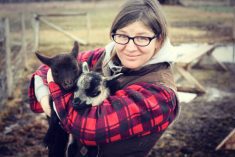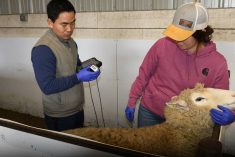The Parkland region of the province takes pride in the quality of its grains and livestock, says a Binscarth sheep producer.
Graham Rannie, along with wife Janice Johnstone, raise commercial and purebred sheep which they’ve sold to producers across Canada.
Up until last July, shepherding was a hobby for Rannie, who worked at the Mosaic Mines near Esterhazy, Sask. for over 35 years. Back in 1984 Rannie took over the home quarter, about 15 kilometres from Binscarth, from his parents. It’s the same yard site his grandfather moved to in 1919. Sheep have been on the farm since 1968.
Read Also

Pig transport stress costs pork sector
Popular livestock trailer designs also increase pig stress during transportation, hitting at meat quality, animal welfare and farm profit, Agriculture and Agri-Food Canada researcher says
In 1985 Rannie bought four purebred Suffolk ewe lambs to start his own flock, only to disperse that flock in 1987. His current Rambouillet flock began when a friend wanted to take a year off from farm- ing in 1994.
Johnstone grew up in the lower mainland of British Columbia where she first became familiar with sheep while in 4-H.
When she and Rannie married in 2004, she and her Border Cheviot sheep flock moved to Manitoba, and is now known as the largest flock of this breed in Canada.
“Border Cheviots compare in many ways with Angus cattle – newborns (relatively low birth weights) are on their feet quickly, looking for a teat,” said Rannie. “For my Rambouillets, I often compare them to Simmental cattle – good volume of milk, large framed, and newborns finish at higher weights than many other breeds.”
Rannie and Johnstone currently own 200 ewes and five guard dogs.
Rannie’s commercial flock is made up of some Rambouillet-Cheviot crosses and sheep with coloured wool. He said the crossbreds produce quality market lambs, and they are developing a flock with fine, naturally coloured wool to meet demand from fibre artists.
“In terms of the market lamb industry, our current system sees lambing in late spring, weaning at about three months, and selling through the winter,” said Rannie. “Highest prices are usually between February and May, with lowest from October to December.
“Lamb prices tend to cycle through the year,” Rannie added. “We’re generally happy if we can average $2 per pound on lambs weighing between 105 to 125 pounds. Selling breeding stock truly helps our bottom line, as to truly make a living solely from sheep, it would require the sale of close to 1,000 lambs per year.”
When the couple started in sheep their production system was relatively intensive, but they now run a mixed operation. A large portion of the fleece wool is sold privately.
Rannie said it’s not easy to direct market lamb meat in Manitoba, as there are not many abattoirs available that will process lambs.
“Thanks to Manitoba not having any federally inspected facilities processing lamb, probably half to two-thirds of lambs produced in the province go east, and others to western markets,” Rannie said.
Rannie said a comparison to cattle sometimes helps people who have direct knowledge of sheep production. And for Rannie, why sheep over cattle?
“Getting run over by a 150-lb. sheep usually doesn’t hurt as much compared to being kicked by a 900-lb. steer,” he said.



















